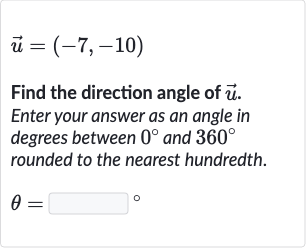Full solution
Q. Find the direction angle of . Enter your answer as an angle in degrees between and rounded to the nearest hundredth.
- Calculate direction angle: To find the direction angle of the vector , we need to calculate the angle that this vector makes with the positive x-axis. The direction angle, often denoted as , can be found using the arctangent function ( or ), which gives us the angle whose tangent is the ratio of the y-coordinate to the x-coordinate of the vector.
- Find tangent of angle: First, we calculate the tangent of the angle using the y-coordinate and the x-coordinate of the vector . The tangent of is given by . For , this is .
- Take arctangent: Performing the division, we get . Now we need to take the arctangent of this value to find the angle in radians. However, since we want the angle in degrees and between and , we will need to adjust the angle we get from the arctangent function accordingly.
- Convert to degrees: Using a calculator, we find the arctangent of , which gives us in radians. To convert this to degrees, we multiply by . The calculator will give us an angle in the first quadrant, but since the vector has negative and components, the actual direction angle is in the third quadrant.
- Adjust for quadrant: The angle from the arctangent function is approximately \atan(\frac{10}{7}) \approx 55.00^\circ. Since the vector is in the third quadrant, we add to this angle to find the correct direction angle .
- Final direction angle: Adding to gives us . This is the direction angle of the vector in the third quadrant, which is between and .
More problems from Inverses of sin, cos, and tan: degrees
QuestionGet tutor help
QuestionGet tutor help
QuestionGet tutor help
QuestionGet tutor help
QuestionGet tutor help
QuestionGet tutor help
Question
. Find the value of in degrees.Write your answer in simplified, rationalized form. Do not round.____
Get tutor helpQuestionGet tutor help

